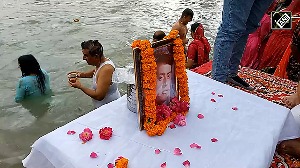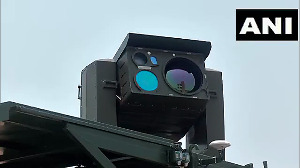Kamal Haasan is right where he left off from the first film but there is only so much he can do to salvage an already lost cause, observes Arjun Menon.

A municipal cleaning truck picks up debris and moves on in the very first images that we see in Shankar's 1996 vigilante drama, Indian.
The shot of the clunky, dusty machine moving out the trash is an obvious way for the screenplay to foreshadow the arc of Senapathy, the film's elderly hero, who is on a mission to weed out corruption from the bureaucracy through vigilante-style killings.
We then see the hero make his way through the corridor of a government office to make his first kill.
It's all weaved together with a 'handmade' quality of believability that cues us for the kind of film you are in for.

Cut to 2024, we get a sequel to the Kamal Haasan starrer through Indian 2, where the actor returns to play the freedom fighter-turned-social justice vigilante figure, whose penchant towards zero tolerance (incidentally also the film's caption) is met only by his utopian ideas of patriotism that thrives on non-violence.
But the sequel begins with a less-than-subtle opening sequence that frames itself through a random day in the life of a YouTuber (one of the film's lead characters), who finds it hard to attest to the inhumane degradation of our daily systems in the face of bureaucratic corruption.
The staging and presentation of this stretch betrays the urgency of the issue at hand and we are just fed data points that deflate the need for clever writing.

In essence, the economy with which Shankar opens the first film is replaced here with a preachy Civics lesson-like template that the film follows in its overall execution.
The first film dealt with a father, who is forced to kill his son after he realises that his offspring is yet another morally compromised hog.
The emotional heft of the Senapathy arc could have been fodder enough for a sequel and one could easily see a reworking of the moral conundrum at the heart of the freedom fighter at the end of the first film, forced to reckon with the moral consequences of his action that prioritised the nation over his blood.

However, Indian 2 is a different beast that is fixated on themes that are an eventual expansion of the ideas in Shankar's more successful films.
His filmography has been dedicated to the concept of a wronged vigilante figure spearheading a one-man crusade against ruthless social institutions.
Right from his directorial debut Gentleman (1993) to Mudhalvan (1999), Anniyan (2005) and Shivaji: The Boss (2007), the director has been engaging with themes of extremist means of social justice as a remedy for individual and collective angst.
There is a method to his over-the-top antics in vigilantism.
The flashy visual style and imaginative scenarios he conjured up in his screenplays helped him achieve the perfect balance in these films and the off-kilter moral lines were subsumed to an extent Shankar's well-intentioned messaging.
However, when the storytelling modes stay painfully inert and redundant, ideological shortcomings start to come to the forefront.
The delivery device for strong, socially conscious statements becomes as important as the messages themselves.

These antiquated tropes of Shankar's film-making sensibilities hold back Indian 2 from delving deep into some of its more interesting thematic threads.
For instance, when Senapathy is called back to action by a young generation beaming with frustration at a malfunctioning bureaucracy, he forces his rules of emotionally distant vigilantism onto the younger folks. This involves individual responsibility and clinical adherence to principle over family obligations, and that's when things start going downhill.
The ruthlessness and bravado of Senapathy's uncharacteristic ways slowly reveals itself for its contradictions and practical limitations, distant from our reality.

This sentiment is strong enough to hold the whole superstructure of Shankar's exuberant world-building, and the presence of the younger generation represented by the satirical YouTube reactionary group Barking Dogs, led by Siddarth should make for an interesting film.
But Shankar undercuts the heft of his themes with some empty calorie set piece business that upends the film's momentum.
The glossy, over-the-top kills become the centerpiece of Indian 2, which was the least flashy, showy element of the original film, almost being treated as an afterthought, running parallel to the main events.
In Indian 2, these become the point and Shankar spends far too much time fetishizing 'Varma Kalai' and you get excessively prolonged kill sequences, where random rich businessmen are tossed off by Senapathy with comical undertones.

'Excess' is an important aspect of Indian 2, as the enigmatic characters of Shankar's previous films are replaced by caricaturish figures who are supposed to be stand-ins for the scattered evils plaguing our country's economic growth.
But the excess of the kill sequences, some of which expand on the lore of the 'Varma' to funny gags, holds back the film from investing time in its primal concerns.
With time, Shankar has picked up the need to stress the superficial over the innate charm of his well-engineered plot machinations.
The result is scenes focusing on Senapathy's victims turning into 'ladylike' and 'horse-like' figures, as an aftermath of the 'Varma' that does not add anything by way of the subject at hand but deviates from the film's urgent social commentary.

Repetitions are an integral part of the 'Shankar Experience' as that is how the filmmaker stresses on his thematic preoccupations.
In films like Indian, Mudhalvan, Anniyan and Shivaji, he deploys motifs of corruption as part of daily life occurrences. Repetitions of these events have a profound impact on the audience's identification with the helplessness of the hero figures, caught in a ruthless cycle of exploitation.
But here, the screenplay has dedicated a chunk of its running time to flesh out irrelevant details that do not drive the plot.
Senapathy becomes an extended side player in his universe, where corruption is limited to gimmicky and exploitative emotional stories involving the 'barking dogs' gang.
Each member of the gang gets episodic stakes thrust upon them and the cipher-like representation slowly mutes into repetitive sermonising and unearned emotional revelations.
Kamal Haasan is right where he left off from the first film but there is only so much he can do to salvage an already lost cause, starting from the slightly off-looking prosthetic makeup that soon becomes a platform for the actor to engage in extended dress-ups and disguises.

The immediacy of the first film is lost in this retelling which could have been a perfect engine for Shankar to Trojan Horse in some discourse about the relevance of vigilante figures and to what extent Senapathy's strict code makes sense in today's society.
The far-reaching promise of this one logline is canceled out by the noisy background elements of Shankar's populated screenplay.
Indian 3 looks more dynamic and promising in the brief glimpse provided by the makers and we can only wait and see what Shankar has in store. But for now, it feels like Shankar's late style turnaround is not a patch on his stellar work from his glory days.












 © 2025
© 2025